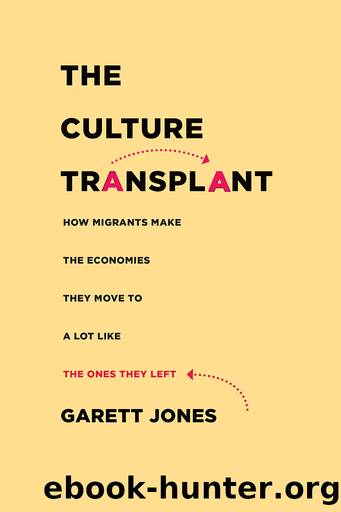The Culture Transplant by Garett Jones

Author:Garett Jones
Language: eng
Format: epub
Publisher: Stanford University Press
Published: 2022-04-15T00:00:00+00:00
And Japan would be number 6 in the left column with 24 Nobels. Switzerland, with just 9 million people, shows up on both listsâthe world owes the Swiss a debt. But as a rule, itâs hard to be a top creator of world-shaking ideas if you donât have a big population. If you want to find a lot of gold, get a lot of people panning for gold.
But how can the T index (Tech History in 1500) matter? Well, thereâs the obvious story that the more things change, the more they stay the same, so if your nationâs ancestors tended to be comfortable with tech in 1500, your nation has a good chance of tech success today. But thatâs not really capturing the why; it doesnât explain the links the chain of cause and effect running from past to present.
As economist James Ang already showed us in chapter 4, Tech History is a powerful predictor of the quality of a nationâs institutions, its governance. With the exception of China, all the top idea-creating nations do well on all the institutional quality listsâlow corruption, a wide embrace of markets, a decent legal system. And notice that China, although in only the middle of global rankings on typical institutional quality measures, does have scale, a massive population, going for itâabout four times that of the United States and sixty times that of South Korea. But even then, China is a bit uneven on idea creation.
So, while on a per-capita basis, China still makes the top 25 percent in global R & D spending, even in total numbers, China never did well on triadic patents at all. When it comes to big global, marketable ideas, institutional quality is almost surely holding China back, way back, and itâs making up for it with quantity. China has moved up a lot in government quality over the past three decades, but itâs got a long way to go before it catches up to the worldâs other majority-Chinese countries: Taiwan and Singapore, and in a limited sense, Macau and Hong Kong.
But letâs not just assume that good government institutions drive innovation. Letâs try to, well, not exactly prove it like a mathematical theorem, but letâs at least look to see if thereâs real-world evidence that good governance helps generate good ideas. Weâve already seen that the Deep Roots scoresâSAT and the restâcapture traits that can cause changes in government quality over the very long run, and weâve already seen that politically important attitudes substantially migrate and last for generations, almost surely shaping government policy. What we should look for now is whether changes in government institutions, changes in the rules of the game, matter for innovation, for R & D, and for patents.
And here, the evidence is abundant. In 2013, two economists, Edinaldo Tebaldi of Bryant University and Bruce Elmslie of the University of New Hampshire, ran some simple, clean tests that create a great first look at the question.6 They start off answering the simplest question:
Download
This site does not store any files on its server. We only index and link to content provided by other sites. Please contact the content providers to delete copyright contents if any and email us, we'll remove relevant links or contents immediately.
International Integration of the Brazilian Economy by Elias C. Grivoyannis(91931)
The Radium Girls by Kate Moore(11930)
Turbulence by E. J. Noyes(7942)
Nudge - Improving Decisions about Health, Wealth, and Happiness by Thaler Sunstein(7622)
The Black Swan by Nassim Nicholas Taleb(7016)
Rich Dad Poor Dad by Robert T. Kiyosaki(6414)
Pioneering Portfolio Management by David F. Swensen(6230)
Man-made Catastrophes and Risk Information Concealment by Dmitry Chernov & Didier Sornette(5926)
Zero to One by Peter Thiel(5691)
Secrecy World by Jake Bernstein(4652)
Millionaire: The Philanderer, Gambler, and Duelist Who Invented Modern Finance by Janet Gleeson(4386)
The Age of Surveillance Capitalism by Shoshana Zuboff(4216)
Skin in the Game by Nassim Nicholas Taleb(4165)
Bullshit Jobs by David Graeber(4101)
The Money Culture by Michael Lewis(4083)
Skin in the Game: Hidden Asymmetries in Daily Life by Nassim Nicholas Taleb(3935)
The Dhandho Investor by Mohnish Pabrai(3706)
The Wisdom of Finance by Mihir Desai(3659)
Blockchain Basics by Daniel Drescher(3511)
